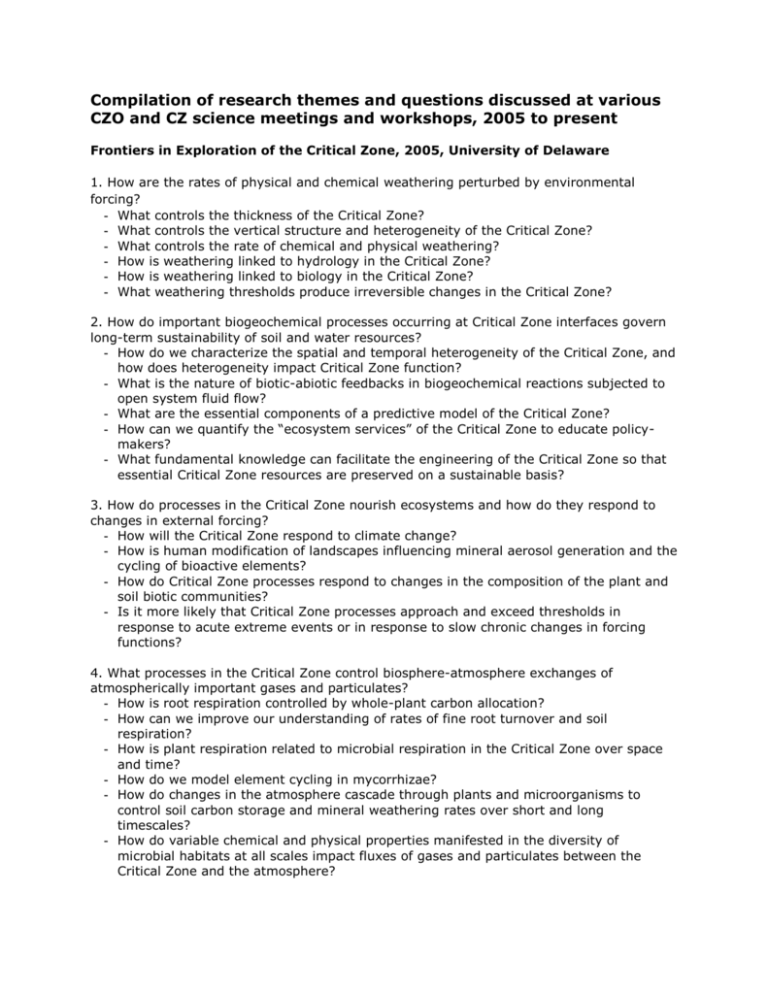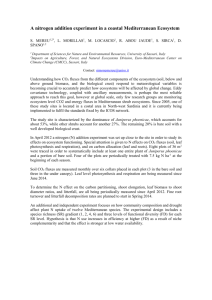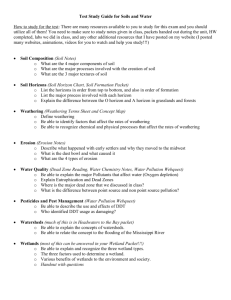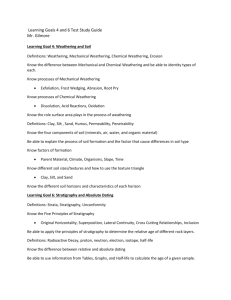Compilation of CZ science questions 2005-2015
advertisement

Compilation of research themes and questions discussed at various CZO and CZ science meetings and workshops, 2005 to present Frontiers in Exploration of the Critical Zone, 2005, University of Delaware 1. How are the rates of physical and chemical weathering perturbed by environmental forcing? - What controls the thickness of the Critical Zone? - What controls the vertical structure and heterogeneity of the Critical Zone? - What controls the rate of chemical and physical weathering? - How is weathering linked to hydrology in the Critical Zone? - How is weathering linked to biology in the Critical Zone? - What weathering thresholds produce irreversible changes in the Critical Zone? 2. How do important biogeochemical processes occurring at Critical Zone interfaces govern long-term sustainability of soil and water resources? - How do we characterize the spatial and temporal heterogeneity of the Critical Zone, and how does heterogeneity impact Critical Zone function? - What is the nature of biotic-abiotic feedbacks in biogeochemical reactions subjected to open system fluid flow? - What are the essential components of a predictive model of the Critical Zone? - How can we quantify the “ecosystem services” of the Critical Zone to educate policymakers? - What fundamental knowledge can facilitate the engineering of the Critical Zone so that essential Critical Zone resources are preserved on a sustainable basis? 3. How do processes in the Critical Zone nourish ecosystems and how do they respond to changes in external forcing? - How will the Critical Zone respond to climate change? - How is human modification of landscapes influencing mineral aerosol generation and the cycling of bioactive elements? - How do Critical Zone processes respond to changes in the composition of the plant and soil biotic communities? - Is it more likely that Critical Zone processes approach and exceed thresholds in response to acute extreme events or in response to slow chronic changes in forcing functions? 4. What processes in the Critical Zone control biosphere-atmosphere exchanges of atmospherically important gases and particulates? - How is root respiration controlled by whole-plant carbon allocation? - How can we improve our understanding of rates of fine root turnover and soil respiration? - How is plant respiration related to microbial respiration in the Critical Zone over space and time? - How do we model element cycling in mycorrhizae? - How do changes in the atmosphere cascade through plants and microorganisms to control soil carbon storage and mineral weathering rates over short and long timescales? - How do variable chemical and physical properties manifested in the diversity of microbial habitats at all scales impact fluxes of gases and particulates between the Critical Zone and the atmosphere? - How do inputs of dust (mineral aerosols) to the Critical Zone impact important soil properties and function and how do changes in the Critical Zone impact the flux and chemistry of dust particulates to the atmosphere? - How do human-induced perturbations impact atmospheric fluxes from the Critical Zone? ‘Frontiers in Exploration of the Critical Zone II: The Geobiology of Weathering and Erosion’, 2009, Smithsonian Institution National Museum of Natural History - Solarto-chemical conversion of energy by plants regulates flows of carbon, water, and nutrients through plant microbe soil networks, thereby controlling the location and extent of biological weathering. - Biological stoichiometry drives changes in mineral stoichiometry and distribution through weathering. - On landscapes experiencing little erosion, biology drives weathering during initial succession, whereas weathering drives biology over the long term. - In eroding landscapes, weathering-front advance at depth is coupled to surface denudation via biotic processes. - Biology shapes the topography of the Critical Zone. - The impact of climate forcing on denudation rates in natural systems can be predicted from models incorporating biogeochemical reaction rates and geomorphological transport laws. - Rising global temperatures will increase carbon losses from the Critical Zone. - Rising atmospheric PCO2 will increase rates and extents of mineral weathering in soils. - Riverine solute fluxes will respond to changes in climate primarily due to changes in water fluxes and secondarily through changes in biologically mediated weathering. - Land use change will impact Critical Zone processes and exports more than climate change. - In many severely altered settings, restoration of hydrological processes is possible in decades or less, whereas restoration of biodiversity and biogeochemical processes requires longer timescales. - Biogeochemical properties impart thresholds or tipping points beyond which rapid and irreversible losses of ecosystem health, function, and services can occur. All Hands Meeting May, 2011, Arizona How can the cross‐CZO‐network be used to develop unified theory of the critical zone that links long‐term geomorphic evolution and architecture to short‐term hydrologic and biogeochemical responses? 1. Climatic and lithologic forcings and disturbance - How does climate forcing (e.g., EEMT) vary in space and time across sites? - When does hydrological and biogeochemical response reflect current forcing or past forcing? - How does CZ architecture reflect long‐term co‐evolution of climate forcing and geology versus short‐term disturbance (anthropogenic or “natural”)? - How do we connect long‐term mean records back to individual events? - How does the distribution of events respond to climate change? - Is it possible to employ reduced complexity characterization of events in long‐term geomorphic models? - How does the event distribution influence different CZ processes and how does this distribution play out across different climate scenarios? 2. Role of biota in CZ function - What is the role of trees in the evolution of the critical zone? - Can the Holdridge Life Zone (see below) scheme effectively describe weathering regimes both within and across parent materials? 3. Time scales of CZ evolution - On what time scales do components of CZ architecture change (hillslope form, soil structure, biological composition) - What is the resilience of CZ systems to climate change? - What are the mechanisms of stability for different processes and how are these connected to the process timescale? 4. Prediction of CZ structure and effects on response - When do hydrological and biogeochemical responses reflect structure? - Can we develop models that predict the basic features of the CZ such as the residence time distribution of hydrologic flows, the denudation rate of the landscape, and the soil thickness? ---Ecohydrology - What are the feedbacks between biological processes, critical zone architecture, and fluxes with implications for: water availability, carbon cycling, nitrogen cycling, limiting factors from soil perspective, weathering and plants? Biogeochemistry - What characteristics of the CZ make it a carbon source or sink? - What is the coupling between mineral transformations and carbon dynamics? - How does the structure of the CZ affect its ability to provide services? Pedology - What is the distribution of soil water storage capacity and the controls on this distribution? - How does soil architecture exert first order control on CZ hydrological and biogeochemical processes across space and time? - What is the residence time and storage capacity of soil carbon across the CZOs? - Can we link observed patterns in vegetation distribution to spatial patterns in soil properties (depth, water storage, carbon content)? - How can CZO help the development of quantitative pedologic models? - Can we identify positive and negative feedbacks and thresholds in soil properties and evolution? - How does the flow of energy influence the formation, evolution and distribution of soil? - How do we quantify clay (carbonate) neogenesis and translocation across lithologic and climate space? Residence Times and Tracers - What catchment and climate properties impact surface water and groundwater residence time distributions? - How can we assess residence times at point to catchment scale? Sustaining Earth’s Critical Zone Nov. 2011, University of Delaware 1. Long Term Processes and Impacts - How has the geological evolution of the regolith (the portion of the Critical Zone consisting of loose heterogeneous material covering solid rock) established ecosystem function and its sustainability within Earth’s Critical Zone? - How do molecular-scale interactions dictate processes in soil and underlying rock, and influence the development of watersheds and aquifers as functional geophysical units? - How can theory and data be combined across scales of observation from molecular- to global- in order to interpret past changes in Earth's surface and forecast Critical Zone evolution and its planetary impact? 2. Short-Term Processes and Impacts - What controls the resilience, response and recovery of Earth’s Critical Zone and its services to perturbations such as climate and land use changes, and how can this be quantified through observations and predicted through mathematical modelling? - How can sensing and monitoring technology, e/cyberinfrastructure and modelling methods be integrated to enable the simulation of essential terrestrial variables and forecasting for water supplies, food production, biodiversity and other major benefits for humankind? - How can theory, data and mathematical models from reactive transport, biogeochemistry, ecology, economics, law, management science and other disciplines Common Science Questions (so-called Dietrich/Lohse document), May 2014 1. What controls CZ properties? - How does the critical zone development depend on lithology? » How do the properties of granitic rocks influence critical zone development? » How do the properties of shale influence critical zone development? - How does geologic history and landscape evolution influence critical zone structure? - How does critical zone development vary with climate? » How does hillslope aspect, as it influences local climate, affect critical zone evolution and structure? - How does critical zone development depend on topography (e.g. slope, relief, hillslope shape, drainage density)? - How does biota influence CZ development? - How do hydrologic and geochemical processes drive critical zone development? - How important is dust accretion in critical zone development? - How has past land use influenced current CZ structure? 1.2 - What controls CZ processes? What controls the chemical evolution of water through the critical zone? What controls organic carbon storage in and flux from the critical zone? How do biota influence solutes and gas fluxes from the critical zone? » What is the role of microbes deep in the critical zone in mediating solute evolution of runoff water and carbon processing? » How does vegetation influence critical zone processes? - How does CZ structure influence hydrologic processes? » How do fractures in the critical zone influence hydrologic and solute evolution processes? - How are CZ processes influenced by fire? 2.1 What will be the response of CZ structure, and its stores and fluxes, to climate change? - How will critical zone processes mediate the effects of climate change on water resources? 2.2 What will be the response of CZ structure, and its stores and fluxes to land use change? - What models best predict how CZO functions and outflows will respond to anticipated land use change? 3. How can improved understanding of the CZ be used to enhance ecosystem resilience and sustainability, and restore ecosystem functions? - How do critical zone processes influence river flow and ecosystems? - How can prediction of future CZO states and functions provide useful guidance in land use management decisions? Frontiers in International Critical Zone Science, May 2014, Beijing, China 1. Mechanistic linkages in flows and transformations of energy, material and genetic information across the vertical and geospatial extent of catchments and aquifers as ecological-geophysical units - Where are the regions located globally where the CZ is most sensitive with respect to global change feedbacks, provisioning and regulatory ecosystem services or has unique research characteristics? - What are the factors and drivers that determine CZ sensitivity in terms of the R3 space (Response, Resilience, Recovery) across scales and how can we predict trajectories of its evolution? - What are plausible strategies for adapting, mitigating and accommodating change in Earth’s CZ? 2. Model Hindcasting of CZ Evolution, Interpreting the Present, Forecasting Future Change and Global Impacts - How does the evolution of the CZ architecture and function (process) inform future land-use options and ecosystem services? 3. The Response, Resilience, and Recovery of the CZ to Perturbations of Environmental Change - How to optimize the multiple CZ functions by understanding, defining and managing the 3Rs (Response, Resilience, Recovery) 4. Integration of Observation and Sensing Technology, e-Infrastructure, and Modelling - To motivate and guide theory development through provision of a platform for innovation in 3D spatio-temporal measurement technologies and wider application of existing techniques 5. Common Observations, Governance and Data Coordination of International CZO Networks - What immediate activities can support the development of a system of governance to define common baseline observations for essential terrestrial variables, index supporting methodologies, establish a culture and operational infrastructure for shared data and information management, and facilitate enhanced networking and virtual and physical scholar exchanges? All-Hands Meeting, Sept. 2014, Fish Camp, CA 1. What controls CZ properties and processes? - How does critical zone development depend on lithology and geologic legacy? - How does critical zone development vary with climate? - How does biota influence critical zone development? - How does hillslope aspect, as it influences local climate, affect critical zone evolution and structure? 2. What is response of CZ structure, stores, and fluxes to climate? - What is the relationship between concentration & discharge? - What factors moderate soil-organic carbon relationships in shallow and deep soil? - How do material & energy fluxes across boundaries relate to climate? - Especially on shorter time scales, what controls biogeochemical stores and fluxes within the CZ? - How do microbial communities (activity, composition) influence biogeochemical stores and fluxes? 3. What is response of CZ structure, stores and fluxes to land use change? - How does the CZ respond to climate change & land-use/management effects? - How does regolith affect vegetation? - How do (bi-directional) vegetation-regolith dynamics influence CZ structure, stores & fluxes, including water & C? - How do material and energy fluxes across boundaries relate to land use change? 4. How can CZ understanding be used to enhance resilience and sustainability, and restore ecosystem function? - How can we apply understanding of the Critical Zone to enhance ecosystem services and patterns such as: water resources, disturbance, ecological indicators, sustainability? 2015 Workshops 1. Concentration-discharge relationships to differences in CZ structure and function across the CZO network. - What can C/Q teach us about CZ structure and response? - More specifically, how does C/Q inform and constrain our understanding of: hydrologic flow paths; solute reservoirs; vegetation interactions; disturbance effects; and reactive transport processes? 2. CZO Network Biogeochemistry. - Evaluating the generality of the Walker-Syer’s (1976) model of the fate of phosphorus during pedogenesis - Diversity and function with depth, including relative abundance of reducers vs. oxidizers, and lithotrophic vs. heterotrophic bacteria - Mycorrhizal impacts and influences on aboveground processes. 3. CZO microbial ecology intercomparison with cyberinfrastructure-enabled data synthesis. - Synthesizing microbial ecology data from IML, CRB, and SS CZOs - Delivering new BiG CZ software into the hands of CZO end-users with an intensive training “bootcamp” - Obtaining feedback on the performance of the BiG CZ software stack for developers; - Developing strategies for broader cross-CZO sampling and synthesis of microbial data - Exploring opportunities for linking CZO data with non-CZO microbial data by crossindexing data archives - Developing international partnerships for global synthesis of CZEN microbial datasets. 4. Developing the construct of “Critical Zone Services. - By focusing on the critical zone and critical zone science, articulation of critical zone services can place many ecosystem services in a broader context. This group will develop these ideas into a peer-reviewed publication that promotes the concept of Critical Zone Services as an amplification of the rich literature on Ecosystem Services. 5. Critical Zone Resiliency To Disturbance: A One Day Early Career Workshop To Develop Testable Hypotheses Using Common X-CZO Measurements. - What determines CZ resiliency across spatial scales from individual sites/observatories to ecoregions? - How can we define and use common measurements to identify locations within the CZ that are resilient (versus vulnerable) to large-scale disturbance, such as global climate change? - How can we use existing climatic and lithologic gradients to predict the capacity of the critical zone to respond to changes in intra- and inter- annual precipitation and evaporative water demand? - How do human activities, which alter energy and mass fluxes, affect critical zone resiliency? 6. Exploring Four Critical Puzzles about Trees, Water, and Soil: A Vision for Research - Where do trees derive their water and how does the subsurface impact this water uptake? - How are stream chemistry and flow affected by trees in an intact forest and why? - How do trees influence soil formation and hillslope evolution (and the reverse)? - How does lithology affect the distribution of trees and subsurface carbon? 7. Salon on the architecture and evolution of the deep Critical Zone - What controls the evolution of the spatial distribution of weathered bedrock properties across actively eroding landscapes? - How can we better predict subsurface CZ architecture from thermal, biological, and hydrological surface drivers? 8. Flux, Stabilization, and Reactivity of Organic Matter in the Critical Zone - Multivariate and chemometric methods for large and complex data set analysis in CZ science - Organic matter dynamics as controlled by erosion and deposition - Mineralogical controls on soil and sediment OM reactivity and persistence.






